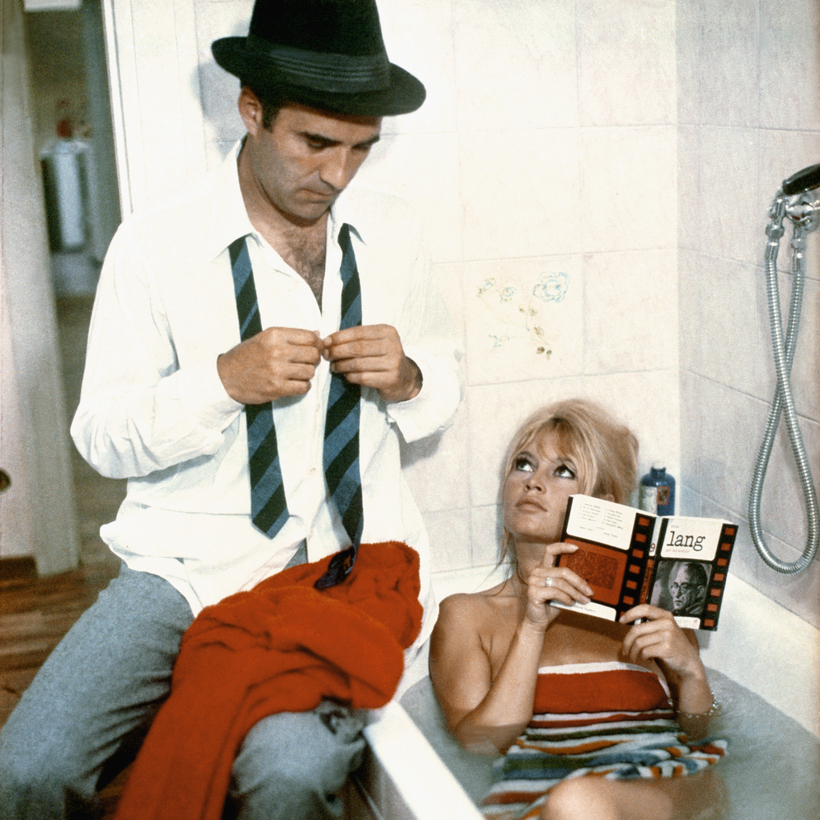In 2020, the year of his 90th birthday, Jean-Luc Godard peers knowingly into the eye of the camera. He runs his hand through his hair and lights a cigar. The interviewer Lionel Baier, head of the Cinema Department at École Cantonale d’Art de Lausanne, politely asks Godard if he is ready. Godard answers, “Yes, yes, I am always ready.” Is it a film, or is it an Instagram Live stream?
Surely no other filmmaker is as fascinated with the distinction between fact and fiction as Godard, and as dedicated to playing with the thin veil that appears to separate the two. For a master of the cinema, a film camera and the unblinking eye of an iPhone must be the same—the gaze through which reality is witnessed.
As Godard once said of Angela, the main character of A Woman Is a Woman (1961), played by his former wife Anna Karina, “She does not distinguish between documentary and fiction, just like me.”

It is impossible to watch Jean-Luc Godard’s interview on Instagram Live and not be reminded of the fabric of images and memories that he has rendered into cinematic legend: Jean Seberg and Jean-Paul Belmondo walking down the Champs-Élysées in Breathless. Karina, smiling like a pretty sphinx, dancing and singing her way through Marx and Mao in Pierrot the Madman. Brigitte Bardot lying on her stomach, reading in the yellow sunlight in Contempt.
These images from the oeuvre of Jean-Luc Godard are singed into the collective cinematic memory as vividly as if they happened in the viewer’s own life.
In the early days of his career as a film critic with Cahiers du Cinéma, the young Godard could be found in the front row of a packed house at the Cinémathèque Française, drinking in the images of shadow and light from the screen like forbidden nectar.

The Cinémathèque co-founder and film archivist Henri Langlois explained Godard’s immersive and obsessive viewing as a passion, saying, “The cinema is a means towards the acquisition of knowledge in the manner of Saint Thomas: by touch. Read all you like about love, but if you haven’t made love, your idea of it will be totally false.”
As devotedly as Godard revered auteurs such as Howard Hawks, Alfred Hitchcock, and Nicholas Ray, he was intrigued by the possibilities of a cinema that would be more like reality, and less like a film—or both at once.
“Read all you like about love, but if you haven’t made love, your idea of it will be totally false.”
He envisioned that his first feature film, Breathless (1960), would be a documentary with actors—that is, shot on a handheld camera (a Caméflex Éclair 35-mm., no less, traditionally used for British newsreels), with little to no additional lighting, and no formal shooting script to speak of.
Godard invented a new kind of independent film production that nodded to the conventions of classic film while exploding those very same limitations of storytelling. The result was revolutionary and radical, with Godard saying that the French New Wave “barged into the cinema like cavemen into the Versailles of Louis XV.”
The curtain of the studio system was torn down, and the very apparatus of filmmaking revealed. By showing reality itself as constructed and referential, Godard anticipated the new media of the 21st century in which livestreams give viewers the appearance of authenticity.

On platforms such as Instagram and Facebook, when someone turns on the camera for a livestream in real time, it is referred to as “going live,” as if life itself could not happen without a camera present. In the perpetual 24-hour news cycle of 2020, audiences have been trained to expect from the news or a livestream a factual representation of reality itself.
Concepts such as “fake news” have dangerously suggested an absolute distinction between truth and falsehood in the representation of reality. Nearly 70 years ago, Godard was already making the point that it is futile to expect reality to be without artifice.
Jean-Luc Godard regards cinema as more than merely an art practice; film is a language, a system of signs and symbols, which can be dissected, reconstructed, and infinitely scrutinized. To what end could turning a camera on real life reveal the truth of the matter, particularly where it mattered most: in love and in politics?
Greer Sinclair is a Los Angeles–based writer

